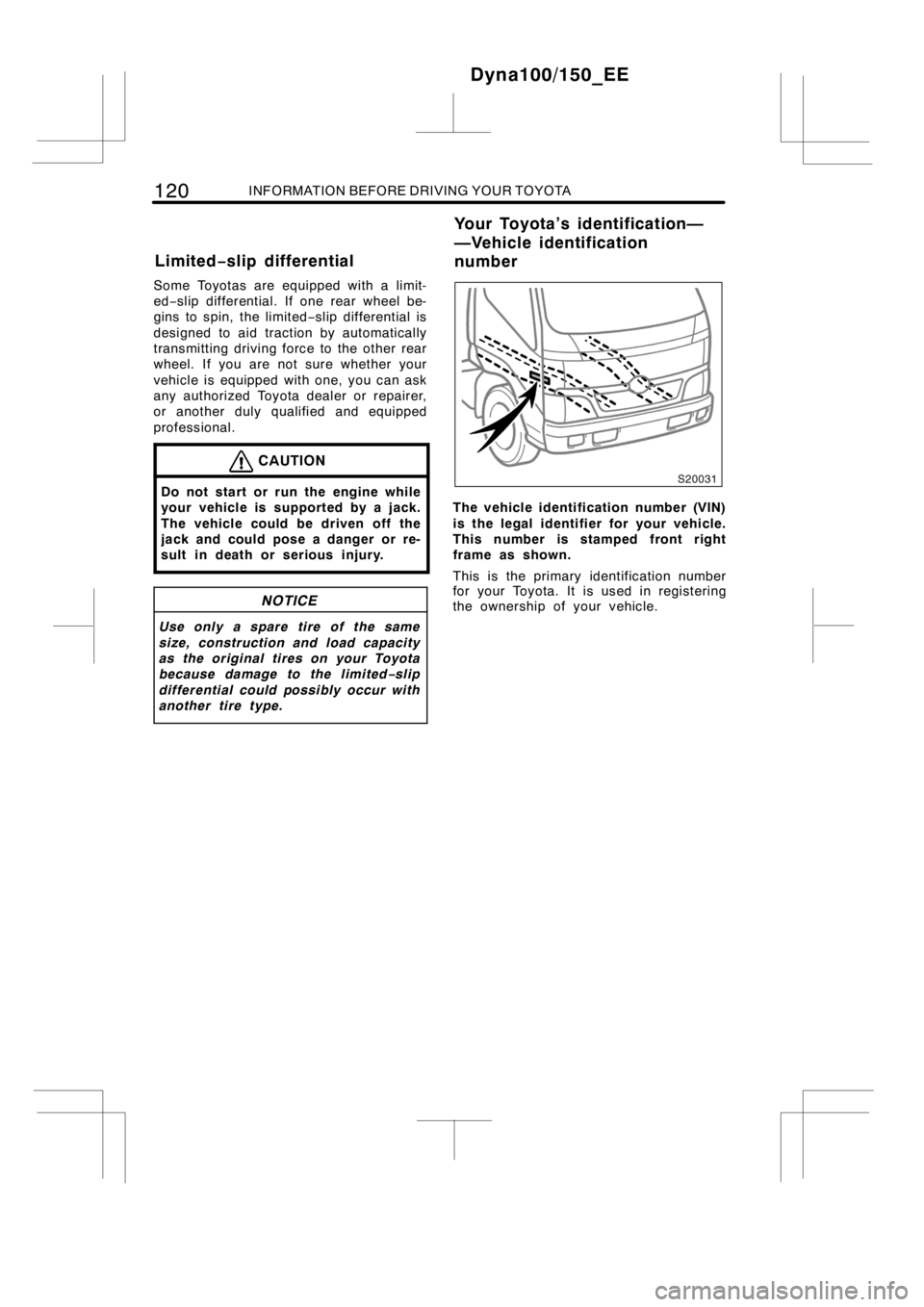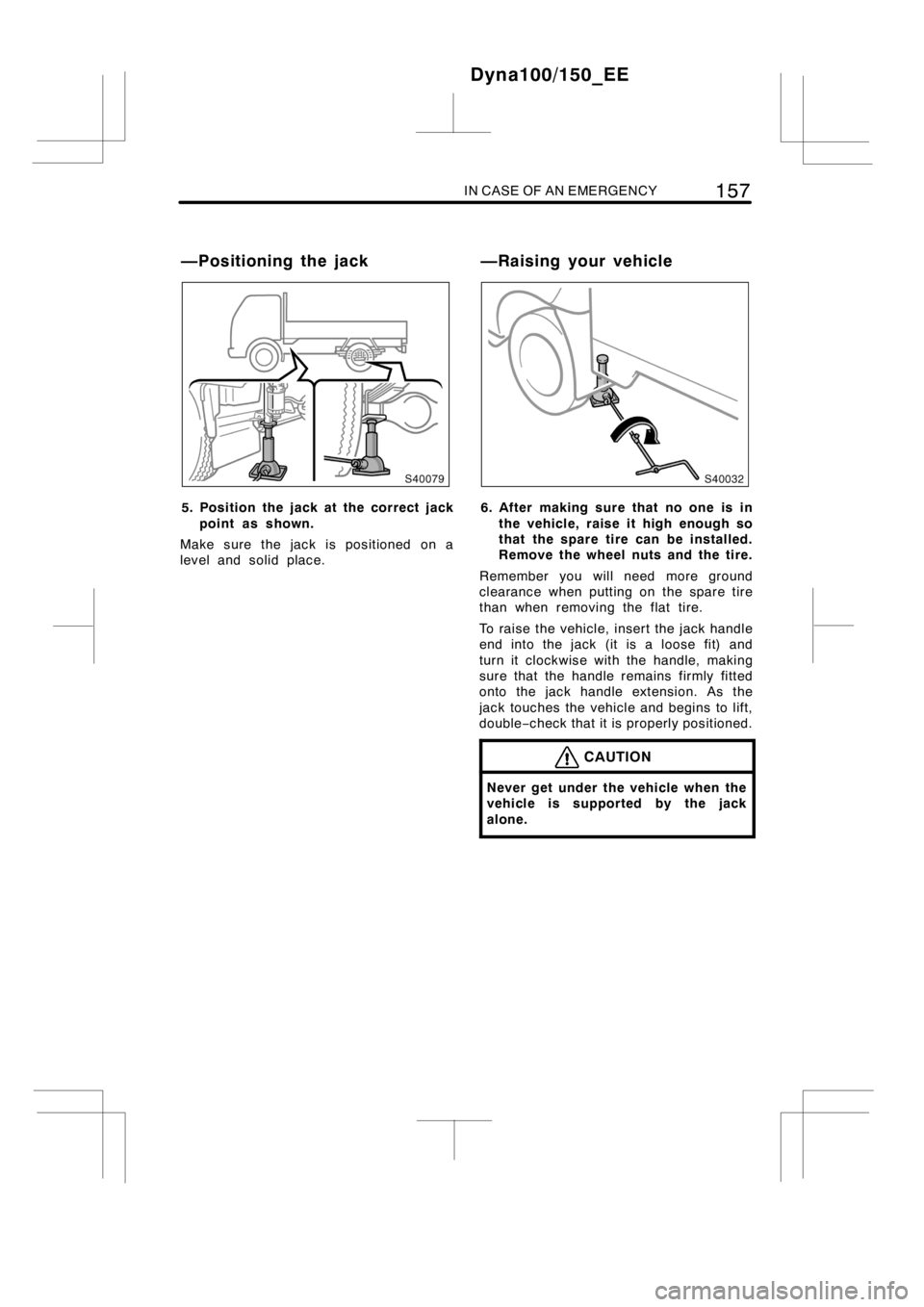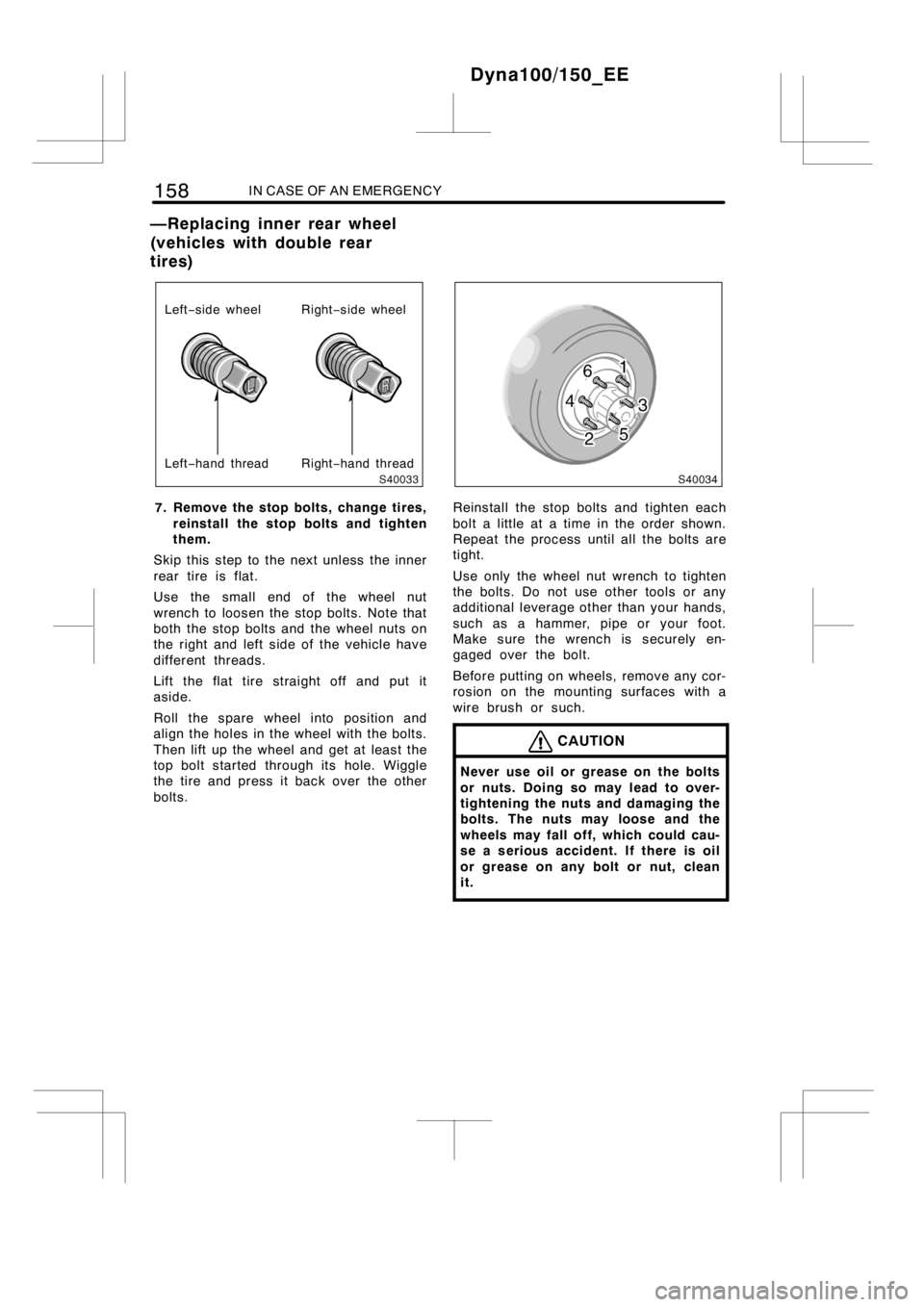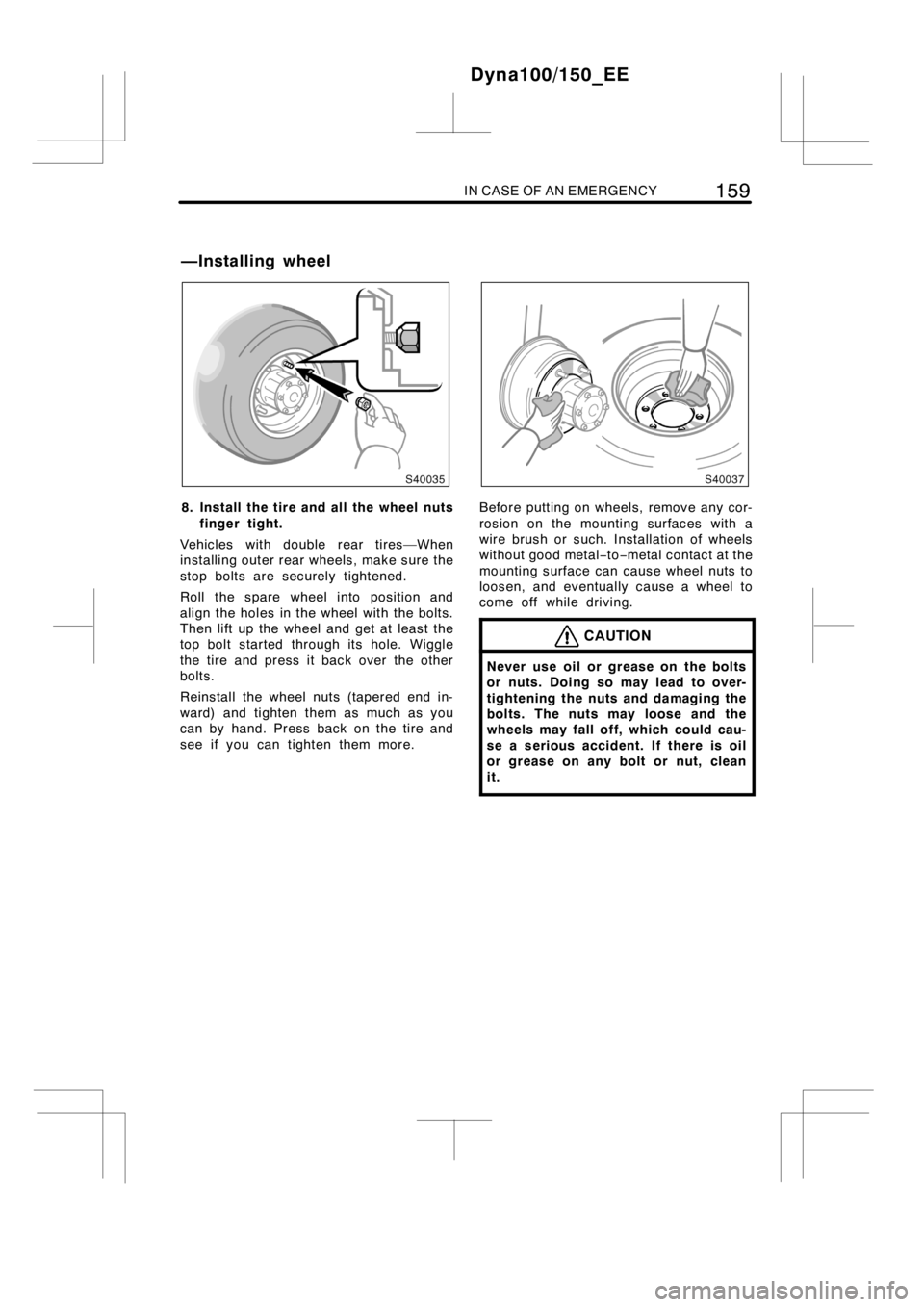2014 TOYOTA DYNA 100/150 spare wheel
[x] Cancel search: spare wheelPage 126 of 232

120INFORMATION BEFORE DRIVING YOUR TOYOTA
Some Toyotas are equipped with a limit-
ed−slip differential. If one rear wheel be-
gins to spin, the limited−slip differential is
designed to aid traction by automatically
transmitting driving force to the other rear
wheel. If you are not sure whether your
vehicle is equipped with one, you can ask
any authorized Toyota dealer or repairer,
or another duly qualified and equipped
professional.
CAUTION
Do not start or run the engine while
your vehicle is supported by a jack.
The vehicle could be driven off the
jack and could pose a danger or re-
sult in death or serious injury.
NOTICE
Use only a spare tire of the same
size, construction and load capacity
as the original tires on your Toyota
because damage to the limited−slip
differential could possibly occur with
another tire type.
The vehicle identification number (VIN)
is the legal identifier for your vehicle.
This number is stamped front right
frameasshown.
This is the primary identification number
for your Toyota. It is used in registering
the ownership of your vehicle.
Dyna100/150_EE
Limited−slip differentialYour Toyota’s identification—
—Vehicle identification
number
Page 132 of 232

126STARTING AND DRIVING
After high−speed or extended driving that
requires a heavy engine load, the engine
should be allowed to idle, as shown in the
chart before turning it off.
Driving condition and required idling
time
Normal city driving
Idling time—Not necessary
High−speed driving
About 80 km/h (50 mph)
Idling time—About 20 seconds
About 100 km/h (62 mph)
Idling time—About 1 minute
Steep mountain slopes or continued
driving above 100 km/h (62 mph)
Idling time—About 2 minute
NOTICE
Do not turn the engine off immediate-
ly after a heavy load has been placed
on the engine in order to prevent en-
gine damage.
It is a good idea to do a safety check
before starting out on a trip. A few min-
utes of checking can help ensure safe and
pleasant driving. Just a basic familiarity
with your vehicle is required and a careful
eye! Or, if you would like, any authorized
Toyota dealer or repairer, or another duly
qualified and equipped professional, will
be pleased to make this check for you at
a nominal cost.
CAUTION
If you make this check in an enclosed
garage, make sure there is adequate
ventilation. Engine exhaust is poison-
ous.
BEFORE STARTING THE ENGINE
Outside the vehicle
Tires (spare included).Check the pres-
sure with a gauge and look carefully for
cuts, damage, or excessive wear.
Wheel nuts.Make sure no nuts are mis-
sing or loose.
Fluid leaks.After the vehicle has been
parked for a while, check underneath for
leaking fuel, oil, water, or fluid.
Lights.Make sure the headlights, stop
lights, tail lights, turn signals and other
lights are all working. Check the headlight
aim.
Battery and cables.All the battery cells
should be filled to theproper level with
distilled water. Look for corroded or loose
terminals and a cracked case. Check the
cables for good condition and connections.
Inside the vehicle
Jack and wheel nut wrench.Make sure
you have your jack and wheel nut wrench.
Seat belts.Check that the buckles lock
securely. Make sure the belts are not
worn or frayed.
Dyna100/150_EE
Precautions for turning off
an engine with turbochargerPre−trip safety check
Page 133 of 232

STARTING AND DRIVING127
Instruments and controls.Especially
make sure the service reminder indicators,
instrument lights, and defroster are work-
ing.
Brakes.Make sure the pedal has enough
clearance.
Spare fuses.Make sure you have spare
fuses. They should cover all the amperage
ratings designated on the fuse box lid.
In the engine compartment
Coolant level.Make sure the coolant lev-
el is correct. (See page 190 in Section
7−2 for instructions.)
Wiring.Look for damaged, loose, or dis-
connected wires.
Fuel lines.Check the lines for leaks or
loose connections.
AFTER STARTING THE ENGINE
Exhaust system.If you notice any
change in the sound of the exhaust or
smell exhaust fumes, have the cause lo-
cated and corrected immediately. (See
“Engine exhaust cautions” on page 114 in
Section 2.)
Engine oil level.Stop the engine and
check the dipstick with the vehicle parked
on a level spot. (See page 188 in Section
7−2 for instructions.)
WHILE DRIVING
Instruments.Make sure the speedometer
and gauges are working.
Brakes.In a safe place, check that the
brakes do not pull to one side when ap-
plied.
Anything unusual?Look for loose parts
and leaks. Listen for abnormal noises.
If everything looks O.K., set your mind at
ease and enjoy your trip!DAlways slow down in gusty crosswinds.
This will allow you much better control.
DDrive slowly onto curbs and, if pos-
sible, at a right angle. Avoid driving
onto high, sharp−edged objects and
other road hazards. Failure to do so
can lead to severe tire damage such
as a tire burst.
Drive slowly when passing over bumps
or travelling on abumpy road. Other-
wise, the impact could cause severe
damage to the tires and/or wheels.
DWhen parking on a hill, turn the front
wheels until they touch the curb so
that the vehicle will not roll. Apply the
parking brake, and place the transmis-
sion in first or reverse. If necessary,
block the wheels.
DWashing your vehicle or driving through
deep water may get the brakes wet. To
see whether they are wet, check that
there is no traffic near you, and then
press the pedal lightly. If you do not
feel a normal braking force, the brakes
are probably wet. To dry them, drive
the vehicle cautiously while lightly
pressing the brake pedal with the park-
ing brake applied. If they still do not
work safely, pull to the side of the road
and call any authorized Toyota dealer
or repairer, or another duly qualified
and equipped professional, for assis-
tance.
CAUTION
DBefore driving off, make sure the
parking brake is fully released and
the parking brake reminder light is
off.
DDo not leave your vehicle unat-
tended while the engine is running.
DDo not rest your foot on the brake
pedal while driving. It can cause
dangerous overheating, needless
wear, and poor fuel economy.
Dyna100/150_EE
Tips for driving in various
conditions
Page 163 of 232

IN CASE OF AN EMERGENCY157
5. Position the jack at the correct jack
point as shown.
Make sure the jack is positioned on a
level and solid place.6. After making sure that no one is in
the vehicle, raise it high enough so
that the spare tire can be installed.
Remove the wheel nuts and the tire.
Remember you will need more ground
clearance when putting on the spare tire
than when removing the flat tire.
To raise the vehicle, insert the jack handle
end into the jack (it is a loose fit) and
turn it clockwise with the handle, making
sure that the handle remains firmly fitted
onto the jack handle extension. As the
jack touches the vehicle and begins to lift,
double−check that it is properly positioned.
CAUTION
Never get under the vehicle when the
vehicle is supported by the jack
alone.
Dyna100/150_EE
—Positioning the jack —Raising your vehicle
Page 164 of 232

158IN CASE OF AN EMERGENCY
Left−side wheel
Right−hand thread Left−hand threadRight−side wheel
7. Remove the stop bolts, change tires,
reinstall the stop bolts and tighten
them.
Skip this step to the next unless the inner
rear tire is flat.
Use the small end of the wheel nut
wrench to loosen the stop bolts. Note that
both the stop bolts and the wheel nuts on
the right and left side of the vehicle have
different threads.
Lift the flat tire straight off and put it
aside.
Roll the spare wheel into position and
align the holes in the wheel with the bolts.
Then lift up the wheel and get at least the
top bolt started through its hole. Wiggle
the tire and press it back over the other
bolts.Reinstall the stop bolts and tighten each
bolt a little at a time in the order shown.
Repeat the process until all the bolts are
tight.
Use only the wheel nut wrench to tighten
the bolts. Do not use other tools or any
additional leverage other than your hands,
such as a hammer, pipe or your foot.
Make sure the wrench is securely en-
gaged over the bolt.
Before putting on wheels, remove any cor-
rosion on the mounting surfaces with a
wire brush or such.
CAUTION
Never use oil or grease on the bolts
or nuts. Doing so may lead to over-
tightening the nuts and damaging the
bolts. The nuts may loose and the
wheels may fall off, which could cau-
se a serious accident. If there is oil
or grease on any bolt or nut, clean
it.
Dyna100/150_EE
—Replacing inner rear wheel
(vehicles with double rear
tires)
Page 165 of 232

IN CASE OF AN EMERGENCY159
8. Install the tire and all the wheel nuts
finger tight.
Vehicles with double rear tires—When
installingouter rear wheels, make sure the
stop bolts are securely tightened.
Roll the spare wheel into position and
align the holes in the wheel with the bolts.
Then lift up the wheel and get at least the
top bolt started through its hole. Wiggle
the tire and press it back over the other
bolts.
Reinstall the wheel nuts (tapered end in-
ward) and tighten them as much as you
can by hand. Press back on the tire and
see if you can tighten them more.Before putting on wheels, remove any cor-
rosion on the mounting surfaces with a
wire brush or such. Installation of wheels
without good metal−to−metal contact at the
mounting surface can cause wheel nuts to
loosen, and eventually cause a wheel to
come off while driving.
CAUTION
Never use oil or grease on the bolts
or nuts. Doing so may lead to over-
tightening the nuts and damaging the
bolts. The nuts may loose and the
wheels may fall off, which could cau-
se a serious accident. If there is oil
or grease on any bolt or nut, clean
it.
Dyna100/150_EE
—Installing wheel
Page 199 of 232

DO−IT−YOURSELF MAINTENANCE: Engine and Chassis193
Keep your tire inflation pressures at the
proper level.
The recommended cold tire inflation pres-
sures and tire sizes are given on page
218 in Section 8.
You should check the tire inflation pres-
sure every two weeks, or at least once a
month. And do not forget the spare!
Incorrect tire inflation pressure may waste
fuel, reduce the comfort of driving, reduce
tire life and make your vehicle less safe
to drive.
If a tire frequently needsrefilling,have it
checked by any authorized Toyota dealer
or repairer, or another duly qualified and
equipped professional.
The following instructions for checking
tire inflation pressure should be ob-
served:
DThe pressure should be checked only
when the tires are cold.If your ve-
hicle has been parked for at least 3
hours and has not been driven for
more than 1.5 km or 1 mile since, you
will get an accurate cold tire inflation
pressure reading.
DAlways use a tire pressure gauge.
The appearance of a tire can be mis-
leading. Besides, tire inflation pressur-
es that are even just a few pounds off
can degrade ride and handling.
DDo not bleed or reduce tire inflation
pressure after driving.It is normal for
the tire inflation pressure to be higher
after driving.
DBe sure to reinstall the tire valve
caps.Without the valve caps, dirt or
moisture could get into the valve core
and cause air leakage. If the caps
have been lost, have new ones put on
as soon as possible.
CAUTION
Keep your tires properly inflated.
Otherwise, the following conditions
may occur and cause an accident re-
sulting in death or serious injuries.
Low tire pressure (underinflation)—
DExcessive wear
DUneven wear
DPoor handling
DPossibility of blowouts from an
overheated tire
DPoor sealing of the tire bead
DWheel deformation and/or tire sepa-
ration
DA greater possibility of tire damage
from road hazards
High tire pressure (overinflation)—
DPoor handling
DExcessive wear
DUneven wear
DA greater possibility of tire damage
from road hazards
Dyna100/150_EE
Checking tire inflation
pressure
Page 231 of 232

INDEX225
N
New vehicle break−in 108................
O
Odometer 70............................
Oil
Consumption 115......................
Oil maintenance management
system 70..........................
Viscosity and grade 188................
Oil consumption 115.....................
OMMS 70...............................
Operation in foreign countries 110........
Overheating, Engine 148.................
Overheating, Engine coolant 68..........
Overview
Engine compartment 180...............
P
Parking brake
Operation 82..........................
Reminder light 82.....................
Parking brake reminder light 73...........
Polishing 171...........................
Power window switches 14...............
Pre−trip safety check 126................
Precautions for turning off an engine
with turbocharger 126..................
Preloader (seat belt pretensioner) 35.....
Pretensioner
(seat belt pretensioner) 35.............
Protecting your Toyota from
corrosion 170.........................
R
Radiator
Checking the radiator 192..............
Coolant, Engine 190...................
Rear fog light switch 64..................
Rear heatersystem 92...................
Rear seat 26............................
Rear view mirrors
Folding 59............................
Outside 59............................
S
Safety check, Pre−trip 126...............
Seat belts
Cleaning 173..........................
Fastening 28..........................
Seat belt precautions 28...............
Seat belt pretensioner 35..............
Seats 24................................
Service and maintenance 176............
Service reminder indicator 73............
Side door locks 13.......................
Side doors 13...........................
Side gate 16............................
Side vents 91...........................
Spare fuse 203..........................
Spare tire 150...........................
Specifications 212.......................
SRS driver airbag 38....................
SRS warning light 73....................
Starting
Cold weather 124......................
Engine 124............................
Jump starting 143.....................
Steering
Adjusting steering wheel 58............
Storage precautions 101.................
Suspension and chassis 122.............
Switch
Emergency flasher 64.................
Engine 80.............................
Headlight, dimmer and
turn signal 62.......................
Heater idle up 93......................
Ignition 80............................
Rear fog light 64.......................
Windshield wiper and washer 65........
T
Tachometer 69..........................
Tailgate 16..............................
Telescopic steering wheel 58.............
Tilt cab 18..............................
Tilt steering wheel 58....................
Timing belt replacement
warning light 73.......................
Dyna100/150_EE